Middle Ages Roman Art Ancent Middle Ages German Art
The Center Ages
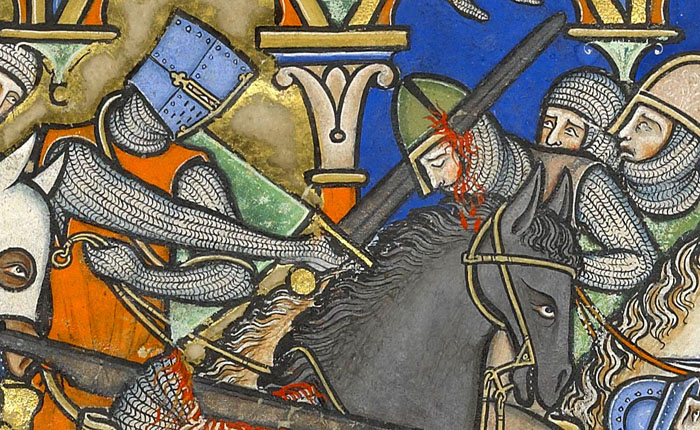
Illustration (detail) to a higher place: "Crusader Bible," 1240 A.D.
The Middle Ages were a critically important period for Western Europe. The preceding "Dark Ages," which lasted for hundreds of years after the fall of the Western Roman Empire, had been a time of chaos and poverty without stiff primal government to maintain order. During the period, Roman roads and water distribution systems decayed. Farming and mining all but ceased entirely. Travel was dangerous and merchandise routes were unused. Birth rates dropped, and illness and infections decimated undernourished human being and animal populations. Western art and civilization were almost non-existent except for what was protected by Christian monks and missionaries. The clergy held fast to the traditions of reading, writing, manuscript illumination, and panel painting in lodge to maintain the Christian faith. Monasteries were the only remaining centers of cultural, educational, and intellectual activity, and consequently they were targets for annexation. In Republic of ireland, successive Viking and Norse invasions forced the removal of treasured books from their original locations so that they could be protected and hidden. A few surviving texts, such as the Book of Durrow, the Lindesfarne Gospels and the Book of Kells are wondrous examples of Christian fine art and arts and crafts.
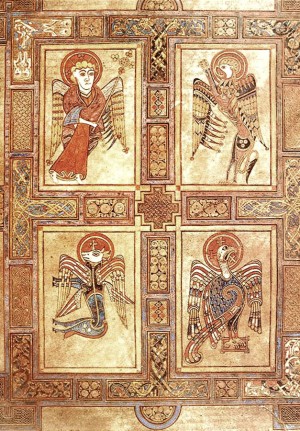
Illuminated page from the Book of Kells, "Matthew, Mark, Luke, and John," 800 A.D.
Light began to enter the Dark Ages in the tardily 700s, when Charlemagne, the son of a powerful warlord controlling vast lands in what is at present Germany, French republic, Austria, Hungary, and the Netherlands, became the leader of the Franks, the largest tribe in Europe. He and his family engaged in decades of armed services incursions and conquests to larn territory, and established a potent central government along with a stabilizing control structure—a feudal organization—which protected the poorest of citizens through regional country-lords with private militias. This authorities united most of Western Europe for the first fourth dimension since the fall of the Roman Empire.
In 800 A.D. Pope Leo, seeing an opportunity to reinstate a Western Church, made Charlemagne Emperor of the Holy Roman Empire. But Charlemagne's goals went beyond political position. Although unable to read and write himself, he valued culture and began a series of efforts to foster it. Monk-scribes and lay craftsmen were imported into the West from the Eastern Roman Empire and began to create books. Scholars helped to constitute standards for writing in Latin so that it could get the unifying formal language of the realm. New "Carolingian" fine art revived Roman realism and combined it with contemporary stylization. For all this, Charlemagne (Charles the Groovy) would be called "the Father of Europe." One of the well-nigh beautiful works of this Carolingian flow was a Gospel book created by the monkGodescalc—an boggling example of craft, fine art, calligraphy, and language.
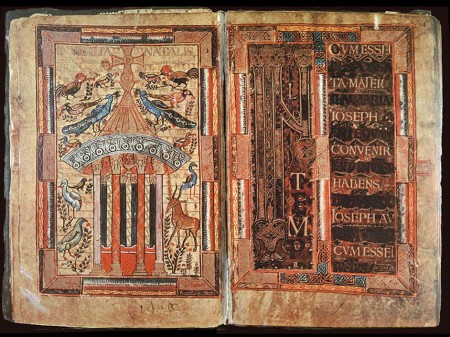
Godescalc Gospels, Carolingian illuminated book (reign of Charlemagne), 782 A.D.
International trade began again in Europe during this time. Culture grew, and by the 1200s art was no longer the sole realm of the Christian clergy. Artisans formed arts and crafts guilds, opened workshops, and sought commissions from the Church, government, the dignity, and the increasingly wealthy merchant form to create frescoes, panel paintings, and illuminated prayer books. I early remarkable example is the illuminated book chosen the Crusader Bible (Morgan Bible) which was created in Northern French republic in 1240 and features activeness scenes complete with battle wounds being inflicted, and detailed realism including specific types of weapons, spurs, armor, and other actual garments.
When the Black Plague struck in 1348-1350, much of what had been gained was in danger of being forever lost again when one-tertiary of Europe's population died. However, wealth became more consolidated in the hands of fewer families, and after recovery from the ravages of the disease there was a render to patronage of the arts—ultimately sewing the seeds for the coming Renaissance.
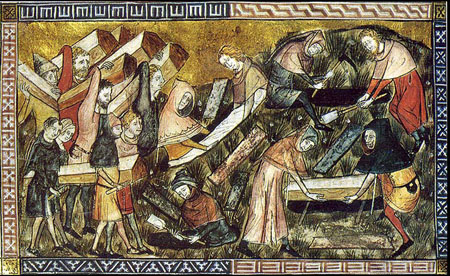
Illumination showing mass burial of plague victims, 1349
Prominent, wealthy patrons deputed beautifully bound illustrated books equally personal luxury possessions. The value of one volume might be equal to that of a subcontract or vineyard because of the toll of materials and salary to the artists. The late 1300s and early on 1400s were the cracking age of the illuminated book and the small-scale, painted illustrations of Jean Pucell, Jean Fouquet and the Limbourg Brothers from that period showed extraordinary skill and achievement. Realism became a dominant arroyo to painting and the Limbourgs showed things never earlier rendered, like shadows, woodsmoke, and the steaming exhalation of breath on a cold day. This fine art rivalled annihilation beingness done in panel painting and frescoe, and all of it was illustrative.
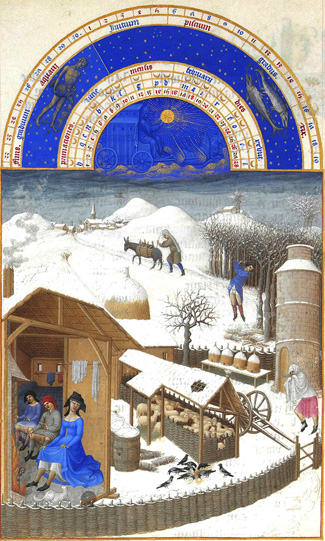
The Limbourg Brothers, calendar folio "February,"LesTrès Riches Heures du Duc de Berry, 1415
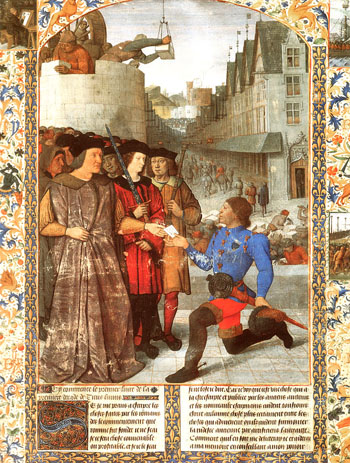
Jean Fouquet, illumination,Chevalier Hours, 1453
0 Response to "Middle Ages Roman Art Ancent Middle Ages German Art"
Post a Comment